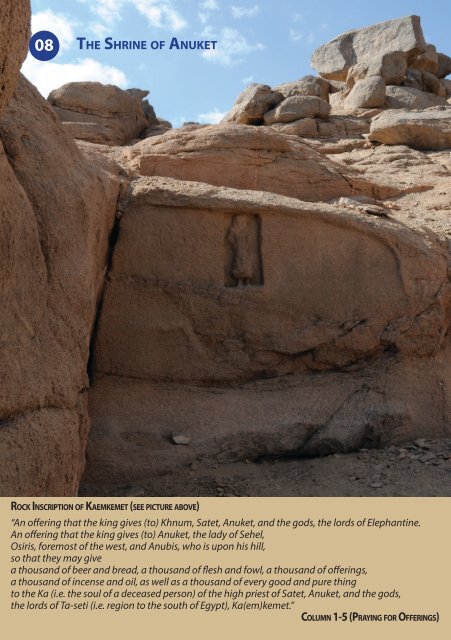The Island Sehel - An Epigraphic Hotspot
You also want an ePaper? Increase the reach of your titles
YUMPU automatically turns print PDFs into web optimized ePapers that Google loves.
08<br />
<strong>The</strong> Shrine of <strong>An</strong>uket<br />
<strong>The</strong> Lady of <strong>Sehel</strong> and her Shrine at Hussein Tagug<br />
<strong>The</strong> main goddess venerated on <strong>Sehel</strong> <strong>Island</strong> was <strong>An</strong>uket, who was also commonly called<br />
the lady of <strong>Sehel</strong>. <strong>The</strong> site of her shrine was most probably located on a narrow terrace<br />
embedded within the eastern hillside of Hussein Tagug, where a broad niche had been<br />
cut into the face of the hill’s granite. Today no visible traces of the shrine’s architecture,<br />
however humble it may have been, are left, but there is strong evidence for the existence of<br />
a prominent ancient sanctuary in this area. First and foremost, the overwhelming number<br />
of dedicatory rock inscriptions assembled opposite and around the niche (see inscription<br />
of Kaemkemet cited below) attests to its religious importance (at least from the late Middle<br />
Kingdom onwards). In addition, two relief slabs made of sandstone were found at <strong>Sehel</strong>,<br />
of which one was later sold to the Brooklyn Museum in New York (see picture below). It<br />
displays two symmetrical offering scenes, in which king Sobekhotep (13th Dynasty, c.<br />
1744-1741 BCE) presents a vase to both female deities of the Triad of Elephantine, and it<br />
once formed part either of a small shrine or an altar dedicated to <strong>An</strong>uket.<br />
<strong>The</strong> situation is thus similar to other sanctuaries in the First Cataract region. As in<br />
the case of the temple of Satet at Elephantine, it is likely that also on <strong>Sehel</strong> <strong>Island</strong> the local<br />
goddess was believed to be immanent in a conspicuous feature of the natural landscape.<br />
Apparently, specific rock formations such as niches, exceptionally shaped boulders or large<br />
potholes were often considered as sacred and, as a result, used as ritual places.<br />
<strong>The</strong> relief of Sobekhotep III<br />
(13th Dynasty, c. 1744-1741<br />
BCE) shows the king offering<br />
a vessel each to the goddess<br />
Satet (left) and to the goddess<br />
<strong>An</strong>uket (right). It probably<br />
formed part of a shrine that<br />
housed the cult image of<br />
<strong>An</strong>uket on <strong>Sehel</strong> <strong>Island</strong>.<br />
(courtesy of the<br />
Brooklyn Museum,<br />
New York)<br />
Rock Inscription of Kaemkemet (see picture above)<br />
“<strong>An</strong> offering that the king gives (to) Khnum, Satet, <strong>An</strong>uket, and the gods, the lords of Elephantine.<br />
<strong>An</strong> offering that the king gives (to) <strong>An</strong>uket, the lady of <strong>Sehel</strong>,<br />
Osiris, foremost of the west, and <strong>An</strong>ubis, who is upon his hill,<br />
so that they may give<br />
a thousand of beer and bread, a thousand of flesh and fowl, a thousand of offerings,<br />
a thousand of incense and oil, as well as a thousand of every good and pure thing<br />
to the Ka (i.e. the soul of a deceased person) of the high priest of Satet, <strong>An</strong>uket, and the gods,<br />
the lords of Ta-seti (i.e. region to the south of Egypt), Ka(em)kemet.”<br />
Column 1-5 (Praying for Offerings)<br />
New Kingdom, 20th Dynasty (c. 1186-1070)<br />
“O living ones upon the earth,<br />
every priest, every god’s-father (i.e. a priest), every lector priest, every scribe,<br />
and everyone who knows his spell who may pass by this stela:<br />
the gods of your town shall favor you, you shall be loved (by) the king of your time,<br />
and shall bequeath your office to your children after old age,<br />
if you will say:<br />
'<strong>An</strong> offering that the king gives (to) Khnum, Satet, and <strong>An</strong>uket of all good and pure things to the Ka of<br />
the high priest of Khnum, Satet, and <strong>An</strong>uket, Kaemkemet!' “<br />
Column 6-12 (Appeal to the Living)

















